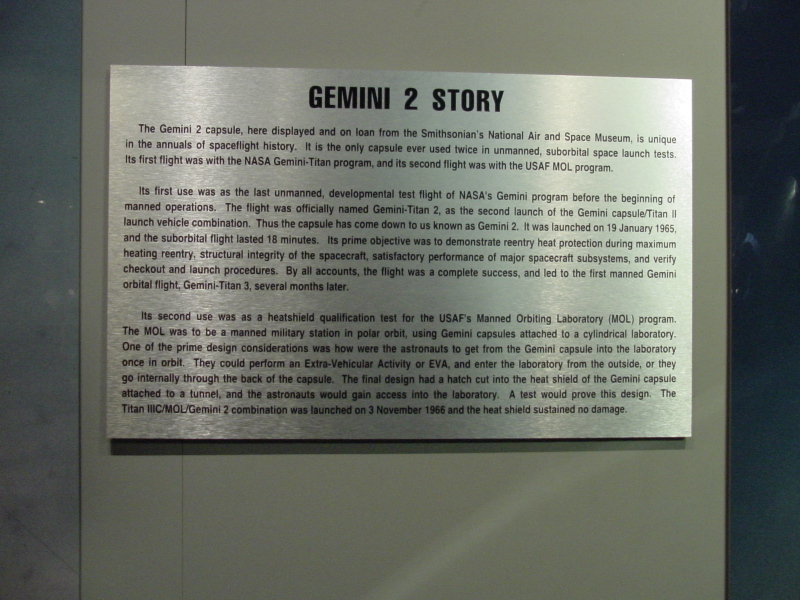| Prev |
heroicrelics.org Kennedy Space Center Site Index Gemini 2/MOL Gallery |
Next |
dsc07355.jpg
A sign next to the Gemini 2 spacecraft. It reads
Gemini 2 Story
The Gemini 2 capsule, here displayed and on loan from the Smithsonian's National Air and Space Museum, is unique in the annuals[sic] of spaceflight history. It is the only capsule ever used twice in unmanned, suborbital space launch tests. Its first flight was with the NASA Gemini-Titan program, and its second flight was with the USAF MOL program.
Its first use was as the last unmanned, developmental test flight of NASA's Gemini program before the beginning of manned operations. The flight was officially named Gemini-Titan 2, as the second launch of the Gemini capsule/Titan II launch vehicle combination. Thus the capsule has come down to us known as Gemini 2. It was launched on 19 January 1965, and the suborbital flight lasted 18 minutes. Its prime objective was to demonstrate reentry heat protection during maximum heating reentry, structural integrity of the spacecraft, satisfactory performance of major spacecraft subsystems, and verify checkout and launch procedures. By all accounts, the flight was a complete success, and led to the first manned Gemini orbital flight, Gemini-Titan 3, several months later.
Its second use was as a heatshield qualification test for the USAF's Manned Orbiting Laboratory (MOL) program. The MOL was to be a manned military station in polar orbit, using Gemini capsules attached to a cylindrical laboratory. One of the prime design considerations was how were the astronauts to get from the Gemini capsule into the laboratory once in orbit. They could perform an Extra-Vehicular Activity, or EVA, and enter the laboratory from the outside, or they [could] go internally through the back of the capsule. The final design had a hatch cut into the heatshield of the Gemini capsule attached to a tunnel, and the astronauts would gain access into the laboratory. A test would prove the design. The Titan IIIC/MOL/Gemini 2 combination was launched on 3 November 1966 and the heatshield sustained no damage.

| Time picture taken | Tue Jun 7 12:35:50 2005 |
| Location picture taken |
Air Force Space and Missile Museum Then and Now Tour Offered via Kennedy Space Center, FL |
| Prev |
heroicrelics.org Kennedy Space Center Site Index Gemini 2/MOL Gallery |
Next |